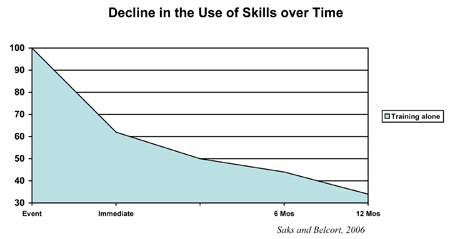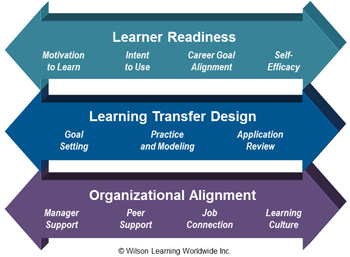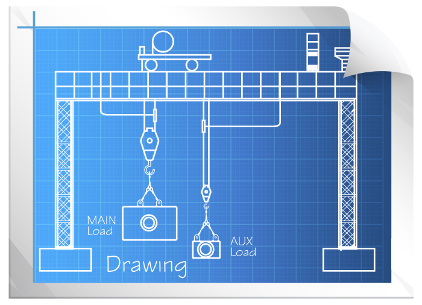Learning Transfer Model
A Research-Driven Approach to Enhancing Learning Effectiveness
Executive Summary
We all know that a seminar alone is not likely to result in significant changes in job performance, and much has been written about different techniques for ensuring that skills transfer into organizational performance improvement. However, while many have promoted specific activities to support the transfer of learning, there has been little research comparing the actual impact of these different techniques. In this study, we reviewed the literature from the past two years and found 32 research studies that compared the impact of training seminars alone to training plus one or more learning transfer activities. This research allowed us to identify 11 specific actions that have a significant impact on whether training results in measurable performance improvement. Overall, we found that if an organization implemented all of these actions, they could improve the effectiveness of their learning by over 180%. The outcome of this research is a model of Learning Transfer that is cost-effective to implement, captures the majority of transfer improvement actions, and has the maximum likelihood of improving the effectiveness of learning in your organization.
Learning Transfer: Enhancing the Impact of Learning on Performance
The fundamental purpose of learning and development is to help people develop skills which, when applied to work, enhance job and organizational performance. While this is widely acknowledged, how we measure the success of learning is not often in alignment with this idea. In fact, the most popular model for evaluating learning and development (Kirkpatrick Model) has three "levels" devoted to measuring learning outcomes and only one measuring performance outcomes.
This focus on learning outcomes, rather than performance outcomes, has also influenced how learning has been designed and delivered for most of our industry's history. More recently, it has been widely researched (and largely accepted) that learning and development, as usually conducted, does not create performance change at an acceptable rate. In fact, most estimates suggest that only about 15–20% of the learning investments organizations make actually result in work performance changes.
For example, the following graph (from research conducted by Saks and Belcort in 2006) shows the decline in the use of learning on the job over time. The research clearly shows that for the average training and development program, there is a steady decline in the use of new skills. It is estimated that only about 35% of the skills are still in use 12 months after the typical training event.

Over the years, a number of people have offered theoretical models for how to enhance learning so it results in greater impact on performance. This work goes under many names: extended learning, learning transfer, transfer climate, and relapse prevention, to name a few. In this article, we will use the term Learning Transfer, because in our opinion, Learning Transfer best represents the desired outcome—transfer of learning to actual job performance.
There are several limitations to these theoretical models. First, most of them are rather complex, containing a large number of factors. Second, they are difficult, maybe impossible, to implement in any practical setting. Finally, while some of the models have a basis in research, they all began from a theoretical perspective, rather than from a practical perspective.
Therefore, the purpose of this research was to answer two basic questions: Can we identify sufficient research that documents the impact of specific learning transfer activities on the use of skills on the job? Then, from that research, can we construct a model that captures the essential components that support learning transfer most effectively?
The Study
The first task of this study was to identify published and unpublished research that met three specific criteria:
- The research compared training alone to training plus one or more learning transfer activities.
- The research reported statistically significant differences between training alone and training plus the learning transfer activities. This had to be more than anecdotal information so we could compare across studies.
- The outcome measures reported in the results needed to be performance outcomes, not learning outcomes.
Using a variety of sources, we identified research studies that met these criteria. We reviewed each study to identify the learning transfer action used and identified how the performance difference was measured between training alone and training plus learning transfer activity. Many of the studies implemented multiple learning transfer activities. As a result, we identified 32 studies that examined 66 learning transfer activities.
Each study used its own statistical method for calculating the performance impact of the learning transfer activities (regression, ANOVA, t-test, etc.). Therefore, for each learning transfer activity, we used the available statistical data and calculated a "difference score" which represented the relative contribution of each learning transfer activity to the difference between training alone and training plus that learning transfer activity. That allowed us to compare across studies, even though they used different statistical methods. This difference score represented the percentage improvement of training plus learning transfer over training alone. For example, a difference score of 20 indicated that the learning transfer activity improved the performance of the participants 20% over training alone.
Finally, to create a model that is less complex and easier to implement than the previous theory-driven models, we grouped similar transfer actions into common transfer activity categories. This led us to the Learning Transfer Model described below.
Findings
In summary, there are three broad conclusions that can be drawn from this research.
- This study provides convincing evidence that learning transfer activities have a meaningful impact on improving the performance results achieved from training alone. Taken together, the research suggests that the impact of learning can be enhanced by as much as 186% when all of the learning transfer methods are utilized.
- While learning transfer has a tremendous impact on performance, any one method may have a relatively modest impact. We found that taken alone, most learning transfer activities will improve performance about 20% over training alone. While significant, this is much below what others claim will happen.
- Finally, there is tremendous variability from study to study on the impact of learning transfer activities. While all of the studies tended to show significant and positive performance impact, the specific percent improvement varied widely. This clearly shows the need for further research in this area.
Learning Transfer Model

As described above, we found that the learning transfer activities researched in these 32 studies can be grouped into three primary categories.
- Learner Readiness Activities: These activities focus on ensuring that the learner is prepared for the core learning event. Activities that address motivation, learner goals, self-efficacy, and testing of prerequisite skills are included in this category.
- Learning Transfer Design Activities: These are activities embedded in the instructional design that are intended to support learning transfer. Practice activities, role modeling, setting learning goals, and application review and support are examples.
- Organizational Alignment Activities: These activities focus on ensuring that the organization supports the use of the skills. Activities here include manager coaching, peer support, connecting learning to the job, and creating a learning culture.
Within each primary category, three to four specific learning transfer activities have been subject to research and have been shown to have an impact on performance.
| Number of studies | Average difference score | Difference score range | ||
| Learner Readiness | ||||
| Motivation to Learn | 6 | 24% | 8% to 42% | |
| Intent to Use | 5 | 18% | 10% to 49% | |
| Career Goal Alignment | 2 | 17% | 9% to 37% | |
| Self-Efficacy | 4 | 11% | 5% to 25% | |
| Learning Transfer Design | ||||
| Practice and Modeling | 5 | 15% | 10% to 22% | |
| Goal Setting | 3 | 11% | 7% to 18% | |
| Application Review | 2 | 11% | 10% to 12% | |
| Organizational Alignment | ||||
| Manager Support/Coaching | 8 | 26% | 10% to 67% | |
| Peer Support | 2 | 33% | 32% to 70% | |
| Job Connection | 3 | 20% | 8% to 37% | |
| Learning Culture | 5 | 13% | 5% to 20% | |
© Wilson Learning Worldwide Inc.
Impact of Learning Transfer on Performance Outcomes
The table at right shows the percentage impact (difference scores) for the different categories of learning transfer activities. For each activity, the table shows the number of studies that included that activity, average difference score, and the range of difference scores.
Learner Readiness
Learner Readiness addresses the preparation given to learners prior to engaging in a learning activity. While things like prerequisite skills and pre-work are important, research has focused on activities that prepare the learner psychologically and emotionally to learn. As a whole, the research suggests that addressing Learner Readiness can increase the effectiveness of learning transfer by as much as 70%.
- Motivation to Learn: Activities that communicate the importance and value of learning to motivate the learner. This includes actions such as promoting lifelong learning, addressing learning anxiety, and overall helping the adult learner appreciate the value of learning.
- Intent to Use: Of course, motivation to learn has less value if the learner does not intend to use the learning. This includes actions focused on helping learners integrate the learning into their work environment and work systems, and motivating them to practice using the skills they learn.
- Career Goal Alignment: Activities that help learners see how the skills align with their ultimate work and career goals. The more a learner sees the skills as valuable to his or her career progression, the more likely the skills will be used and have a positive impact on performance.
- Self-Efficacy: Addressing the learner's belief that he or she has the capacity to learn and that the learning will result in a meaningful change in performance.
Learning Transfer Design
Research has shown that how the learning process is designed also has an impact on the degree to which the learning will transfer to work performance. This is what we mean by Learning Transfer Design. The three elements that have been researched, taken together, can enhance learning transfer by up to 37%.
- Practice and Modeling: The more the learning design includes practice and behavioral modeling during learning, and the closer that practice and modeling replicate real-life situations (referred to as "fidelity" in the literature), the greater the transfer of learning to work.
- Setting Learning Goals: When learners set specific goals for their learning, either behavioral or performance goals, the likelihood increases that they will use the skills in their work.
- Application Review: Extending the learning beyond the initial event by including content reviews and, more importantly, reviews of how to apply the skills to specific work tasks has also been shown to improve the impact of learning.
Organizational Alignment
Finally, the transfer of learning also relies on the degree to which the organization is aligned with and supports the learning and use of new skills. While a number of things can constitute Organizational Alignment, research has primarily investigated four.
- Manager Support/Coaching: Studies have shown that the more managers are trained in how to support and coach the skills their employees learn, the more those skills will be used and sustained in the workplace.
- Peer Support: While manager support is seen as critical, research suggests that the support of learners' peers may be equally or more important. While there have only been two studies, both studies show peer support to have a very high level of impact on improving learning transfer.
- Job Connection: The clearer the link between the skills taught and the skills required of the job, and the more the skills are integrated into work processes and systems, the greater the transfer of learning to work. While this may seem obvious, the research suggests that this does not always happen.
- Learning Culture: The degree to which the organizational culture supports change and the use of new skills has a significant impact on the transfer of learning to the work environment.
Recommendations
Not all learning transfer activities are needed in every learning environment. However, the research does indicate that all learning events can benefit from additional actions specific to supporting the transfer of learning to the workplace.
Our experience indicates that learning transfer activities need to be considered along with all other factors of any instructional design process. In the development and launch of any learning program, organizations should ask questions such as:
- How do we know the learner audience is ready for this learning event, and what is the best way to prepare them to learn and use the skills?
- How is goal setting included in the learning process?
- What forms of practice and modeling are best for this content and this learner audience?
- What kinds of learning review and application support are needed to ensure use of the skills after the learning event?
- What is the best way to align the organization to support the use of the skills learned?
- Are managers and peers prepared to coach and support the application of the learning?
- Will the organization's culture support the use of learning, or will it be a barrier? How can the culture be altered if it is a barrier?
One approach we have taken with clients has been to help them build a “Learning Transfer Balance Scorecard” to identify where they are supporting transfer, what the impact has been, and where they could do more to improve the return-on-investment of their learning.
Conclusion
Activities that enhance the transfer of learning into workplace performance will have an important impact on an organization's performance and can significantly increase the return-on-investment for training and development efforts. This study provides convincing evidence that learning transfer can have a tremendous impact on the effectiveness of learning. Indeed, results suggest that if all of the techniques studied above were simultaneously implemented, the impact of learning could be increased 186 percent.
This research also suggests that the actions that need to be taken are relatively clear and easy to implement. A few key activities, appropriately timed, can have a tremendous impact on organizational performance and the sustainability of learning.










 Please complete this form to download Learning Transfer Model | A Research-Driven Approach to Enhancing Learning Effectiveness.
Please complete this form to download Learning Transfer Model | A Research-Driven Approach to Enhancing Learning Effectiveness.



